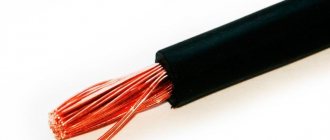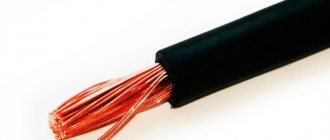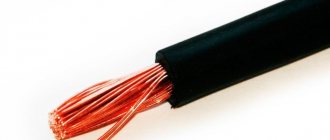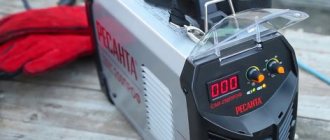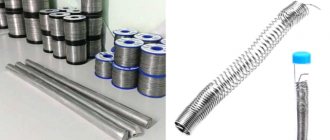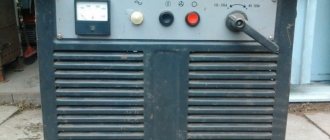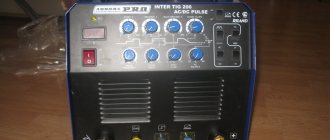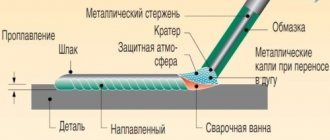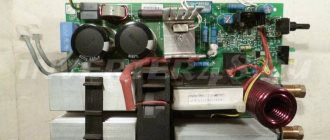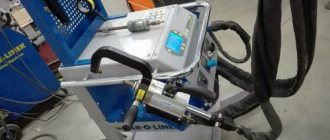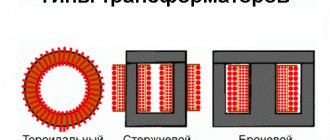An electrode holder for a welding machine is one of the elements of welding equipment. They come in different characteristics and designs. The main task of the holder is clear from its name: holding electrodes at various angles, including 180° relative to the handle; ensuring reliable contact with the supply cable; insulation of electrically conductive parts. Welding “holders” are divided into household and professional, the main difference between the professional one is the presence of copper contact plates and a reliable clamping device. For household ones, pressure jaws can be made of aluminum or even just thin iron (stamping).
Requirements for holders
Regardless of the design details, the welding holder must satisfy the following requirements:
- ensuring the welder is insulated from high voltage;
- thermal insulation of the holder handle;
- reliable fastening of the wire;
- low resistance for passing currents up to hundreds of amperes;
- reliable fixation of the electrode;
- quick and convenient replacement of a used electrode with a new one.
Reliable fixation and quick replacement are a seeming contradiction. They are resolved by design solutions.
Welding accessories
An inverter, a holder and an electrode are not yet electric welding; additional accessories are needed to perform a faster and better range of tasks. Such devices as: pouches; tees; extension cords; drying ovens for equipment; hoods: magnetic corners and clamps can make working conditions more comfortable and safer. When replacing the protective glass with an automatic “chameleon”, which changes the amount of transparency depending on the brightness of the arc, you don’t have to be afraid to “grab the hare”, but also do the job better because the glass will automatically select the required light transmission, ensuring optimal visibility of the weld. On our website you can select all the necessary accessories for welding work, from a transformer to an autonomous power station to power it.
Factory fastener models
The welding equipment industry produces several main types of holders. They vary in design, but any welding holder meets national or international standards.
Trident
To put it mildly, it’s a traditional, but frankly, outdated design. It is extremely simple and consists of three elastic parallel rods placed at a distance of 1-1.5 cm from each other. The end of the electrode is clamped between the free ends. Despite the high utilization rate of welding materials and low cost - such a holder for a welding machine can be made from a 6-8 mm rod in 10 minutes - it has been discontinued in all developed and most developing countries. Some quantities may be sold on the secondary market.
Trident holder
The reason for the ban is the danger of high voltage injury and the high risk of corneal burns from ultraviolet radiation. It will take a lot of effort to remove the cinder.
Trident with spring
It basically repeats the design of a trident, with the difference that the middle rod is spring-loaded. This makes it much easier to remove and install the electrode. However, all the disadvantages and risks to the welder’s health remain. Such electrode holders for welding machines are also not officially produced, but many home craftsmen make them themselves. They are attracted by the reliability and ease of changing the cinder in this design.
Trident with spring
Threaded collet electrode clamp
This modern design of the holder is characterized by ease of changing the electrode, pleasant appearance and ergonomic handle.
Replacing the cinder is done quickly and without much effort. The disadvantages include a limitation on the maximum current and the need to leave a large cinder - otherwise the plastic case can be damaged. The design is characterized by minimal weight and dimensions. Used primarily for precision welding of small-sized parts with low currents.
Threaded collet electrode clamp
Collet electrode clamp
One of the most common designs. The electrode is clamped by a spring-loaded lever. The clamp is produced in many sizes for different electrode diameters and different welding currents. Ergonomics suffer a little due to the protruding lever, but this disadvantage is compensated by a reliable grip, a large contact area with the electrode, and, consequently, high permissible operating currents. Requires significant effort to press the lever when removing and installing the electrode.
Holder-clamp
DIY welding holders: how to make a welding holder
If a home craftsman wants to save some money or just test his capabilities, then he will be able to make a holder for a welding machine with his own hands. A homemade product will be somewhat inferior to factory products in appearance and performance, but will be quite reliable. Below we will talk about several popular designs.
DIY trident
You can repeat this design in a few minutes. - To make it, just a few pieces of round rod or fittings with a diameter of 6-8 mm and a piece of rubber hose to insulate the handle are enough. Of course, you will also need a welding machine.
Important! It is necessary to thoroughly clean and solder the place where the welding cable is connected to the holder.
The holder will turn out to be a little scary, but quite reliable. During care, you will have to periodically clean the rods from scale at the point of contact with the electrode.
Homemade trident with a spring
Metal corner and reinforcement rod
A single rod is welded with one end to the inner corner of the corner, and with the other it presses the electrode to its side edges.
This option will turn out to be heavier and even more unsightly, but due to the improved contact between the rod and the holder, it will be more reliable and stable in operation. The design retains all the same risks as the trident.
How to choose a welding cable
Having understood the labeling of goods, let's move on to practical advice on choosing. The welding cable must match the machine with which it will interact. There are other parameters that are selected based on the upcoming welding tasks.
What should be the core of the welding cable?
The welding cable connected from the device to the holder and ground can be single-core (for example, 1x16). The first number means that in cross-section it has a common core, not divided into two or three isolated lines under a single shell. This design reduces heating and promotes accelerated voltage transfer from the source to the holder.
Single-core welding cable.
Multicore cables are designated 11x30, where the first digit indicates the presence of 11 separate cores. This design is used in industrial installations using voltages of 500 A and higher.
Multicore welding cable.
The core itself can be aluminum or copper. In stores, welding machines are most often equipped with aluminum cables, since they are cheaper. This is enough for a novice welder or rare use of an inverter.
Aluminum welding cable.
Professionals always install copper cables, since their resistivity is 7 times less than that of aluminum. As a result, current losses are reduced. Copper also bends better and heats up less.
Copper welding cable.
A cheap Chinese cable may be called copper, but contain no more than 70% Cu. This is easy to notice by the dull color of the vein in the section. The product is suitable for household needs, but for production it is better to abandon it.
Welding cable cross-section
Inside the metal core there are thin wires, which can be from 30 to 1000. Their total cross-section is selected according to the power of the device and the current used. For example, a cable with a cross-section of 1x6 mm² is designed for a maximum load of 11 kW with a current of 80-100 A. But you should never use the calculated values to the maximum. It is optimal to always divide them by 2. As a result, such a wire is suitable for a power source with a power consumption of 5 kW. As the current strength (A) increases, it is necessary to increase the cross-section of the cable, otherwise it is the same as trying to refuel a car at a gas station through a straw - the narrowed passage will reduce performance.
To avoid losses of welding current, the cross-section is selected based on the output power of the device according to this table.
| Current strength, A | Cable cross-section, mm² |
| 80-100 | 1x6 |
| 120-150 | 1x10 |
| 150-180 | 1x16 |
| 200-250 | 1x25 |
| 250-300 | 1x50 |
| 330-400 | 1x100 or 11x50 |
| 500-600 | 1x120, 11x95 |
| 600 | 1x185 and higher |
If you cook with a “two” at a current of 80 A, then you can easily get by with a thin cable 1x6 mm². But this will not allow using the “troika” electrode. Therefore, the devices must be equipped based on the possible maximum welding current. For a household inverter in a country house, a minimum value of 1x16 mm² is sufficient. The workshop needs 1.25 or 1x50 mm². Working with a cable with a smaller cross-section leads to overheating and melting.
Cable flexibility requirements
For welding, a cable with a flexibility of at least class 4 is required. Stiffer wires will twist the welder’s hands, they are more difficult to wind up for transportation, and it is inconvenient to manipulate the holder when welding in a ceiling or vertical position.
The cord with the designation KG belongs to the 5th class of flexibility. Its “hair” diameter is 0.41 mm. Products marked KOG belong to class 6. Increased flexibility is achieved due to the “hair” diameter of 0.21 mm.
Cable insulation
The cable sheath is manufactured in accordance with GOST 23286-78. The insulation should not be thinner than 1.1-1.2 mm in order to reliably protect the current-carrying part from exposure. The outer winding is made of rubber with the addition of various components. It should feel soft and flexible to the touch. The insulation class is indicated by letters and indicates the maximum heating temperature that the shell can withstand.
For example: index F means 150 degrees, and H means 180.
Fork with spring
This is an advanced version of the trident. The rods must be made of high-quality elastic stainless steel; the middle rod at the base is curled with one or two spring coils. The rod spring-loaded in this way ensures quick and convenient replacement of the cinder.
Due to the preservation of exposed live parts under high voltage (about 100 volts), this option also poses a risk of electric shock. In addition, this homemade welding holder will cost significantly more due to the cost of materials and the additional operation of winding the spring, which requires special equipment or tooling.
Threaded and collet fasteners
For the threaded fastener you will need a ready-made collet clamp. Self-production is also possible, but you will need a drilling or milling machine and a set of hand tools. You will have to make a shaped nut with an internal cone and a cone-shaped slotted clamp with an external thread and an internal hole that matches the diameter of the electrode. This will take several hours.
Homemade collet holder
The clamp holder is simpler in design; the lever and base can be made of a thick metal strip. This will ensure sufficient contact with the electrode.
Which holder to choose
The choice of holder depends on the type of welding work most frequently performed. When comparing different models, you should pay attention to the following properties:
- Technical specifications. The maximum permissible current should be 10% HIGHER than indicated in the welding machine passport. Too large a reserve does not make sense, but will only lead to increased fatigue of the welder due to greater weight
- Dimensions and weight. This is especially important if a large amount of work is planned. In a few hours of welding, the extra 100 grams of weight and 5 centimeters of length will turn into pounds of weights.
- Terms of Use. If you plan to work outdoors, at low or, conversely, high temperatures, high humidity, etc., the holder material must withstand these tests and not crumble after a week.
- Price. The range here is simply amazing - from 200 to 15 thousand rubles. The choice depends on the list and volume of planned work. If you need to weld a corner to a fence once a week or repair a cultivator frame, 200 rubles will do the job. Advantages of ESAB collet holder for 15,000 rubles. will appear only with professional use and large volumes of welding work.
Variety of welding machine holders
It would be wise to purchase an inexpensive holder in reserve so as not to interrupt important work if the main one suddenly fails. The holder will last much longer if you take care of it regularly. The clamp must be kept clean and regularly cleaned of scale and other contaminants. Good contact with the electrode will ensure the planned quality of welding and extend the service life of the device.
Now about the addition to inverters
These are autonomous power sources. If you conduct a short review of welding generators, manufacturers present their products as a generator, an autonomous power supply, a power plant, don’t let the name confuse you - they are one and the same. Autonomous power supplies are divided into types based on the engine: gasoline; diesel; or a gas generator. Which, in turn, are divided by power and type of cooling - air-cooled; liquid and mixed. Now you need to understand how to use it.
If it is clear with the engine and fuel, then the type of cooling is worth stopping; as a rule, air-cooled engines are designed for a short operating time, especially at maximum power and after a short operating time, they require a rest to cool down. Liquid-cooled engines are designed for continuous operation and their operation is limited only by fuel resources at rated power use. Gas fuel engines are the most economical, but also the most expensive, slightly cheaper than diesel engines, the cheapest and most common are gasoline 2-stroke or 4-stroke single-cylinder, less often two-cylinder.
So which generator should you choose for welding? The fact is that the indicated power of the generator and welding do not match, namely, the transformer uses an active current load in the form of an arc and low voltage, while for generators the power is calculated in the usual way, the constant voltage is multiplied by the current. So, since the generator produces a stable voltage, sharp starting surges or voltage fluctuations during an arc break are perceived by the generator protection as a network malfunction and a shutdown occurs. This is especially true with modern small-sized inverters. For this reason, if you plan to use the generator for welding, then it is necessary to select its power 10-15% more than indicated on the inverter. Giving accurate tables and recommendations is not a rewarding task, because... Each device is individual. If there is a need to purchase separate units, then it is best not to be lazy. take the inverter with you to the store and test it when purchasing, choosing the “right” generator that will work normally with it in tandem.
Combined generators
To avoid such problems, dual or combined generators and inverters have been developed.
Such machines are distinguished by already selected characteristics and when purchasing, you can accurately focus on the specified parameters and power. In addition, the generator can be used in addition to welding for other electricity consumers. Attention! Manufacturers warn that it is imperative to use a dual machine in welding mode without connecting additional power sources, especially power tools, since this load is reactive, and the combined use of reactive and active loads from one source can damage the unit’s protection system.
The industry produces a large number of self-generators of varying power and cost; here is one of them:
The device of the Italian brand is the Mosa MSG CHOPPER welding generator. The generator has one of the best characteristics of a combination of autonomous engine mode and generator characteristics in the form of welding current. The generator allows the use of electrodes with a current of up to 200 A. of various types: ordinary, stainless, with alloyed additives. It is designed for long-term operation in welding mode, and a 60% coefficient of continuous switching (continuous switching time) means that the device can operate for 10 minutes - 6 work, 4 rest, at maximum current (in cutting mode).
Below are the characteristics of the generator
| Power, R nom, kW: | 1, 8 |
| Power, Rmax, kW: | 2 |
| Voltage, UB: | 230 V |
| Number of phases: | 1 |
| Start: | manual |
| Execution: | in a casing |
| Type of current: | constant |
| Welding current, I nom, A.: | 165 |
| Welding current, I min, A.: | 50 |
| Electric/wire diameter: | 2.0 – 3.5 mm |
| Fuel consumption at I rated: | 1.5 l/h |
| Fuel tank, l: | 3 |
| Degree of protection: | IP 23 |
| Noise level: | 77 dB |
| engine's type | Petrol |
| Manufacturer: | MOSA |
| Cooling: | air |
| Engine speed rpm: | 6000 |
| Dimensions (AxBxS) | 570x 300x410 |
| Weight: | 29.5 kg |
| Manufacturer (brand): | Italy |
| Guarantee: | 1 year. |
| Price: | RUB 138,739 |
| Attention Bearing Buyers Dear customers, send your questions and requests for the purchase of bearings and components by email or call now: Delivery of bearings throughout the Russian Federation and abroad. Bearing catalog on the website |
Attention Bearing Buyers
Dear customers, send your questions and requests for the purchase of bearings and components by email or call now: +7 [email protected] Delivery of bearings in the Russian Federation and abroad. Bearing catalog on the website
themechanic.ru
What features of the device should be taken into account
The most significant features of the device that you need to pay attention to are briefly formulated below:
- Ergonomics, weight, linear dimensions.
- Condition of the clamping device: reliability of contact between the jaws and the cathode, quality of surface treatment.
- Handle insulation quality. A hundred volts can not only scare, but also easily kill.
- Maximum operating current and diameter of electrodes compatible with the holder.
- Reliability of welding cable connection. The best connection is soldered, followed by threaded connections in terms of quality. Chinese crimp connections are best left on the shelf.
A correctly selected welding machine holder in a store or a well-made one with your own hands will provide the opportunity to do what you love without being distracted by little things like a dropped rod or a fallen cable.
